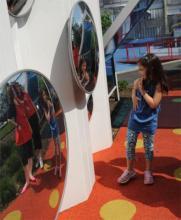
The New York Hall of Science (NYSCI) launched The Sara Lee Schupf Family Center for Play, Science, and Technology Learning (SciPlay) in September 2010. Sara Schupf created the Center to engage more children with science concepts and scientific thinking through outdoor playgrounds. Her goal for SciPlay was both to inspire children's interest in science through outdoor playgrounds and to encourage teachers to utilize the playground as an avenue for science learning.1
Initially in 2007, Sara joined forces with New York City's Mayor Michael Bloomberg's PlaNYC goal to bring green space to within a ten-minute walk for every New Yorker by 2030.2 The mayor's plan was to convert 290 schoolyards into playgrounds and community parks. School administrators, teachers, and students worked with landscape architects in redesigning the play spaces.
Sara, through the Board of Advisors that she had gathered, commissioned Jane Clark Chermayeff & Associates LLC (JCC&A) to produce a catalog of playground equipment that involved science concepts and tied into New York City's science core curriculum for grade school through middle school.3 Through the Trust for Public Land and the Department of Parks and Recreation, the catalog was delivered to schools in the fall of 2008.
Six NYC schools were chosen to pilot SciPlay play spaces by choosing play components from the SciPlay catalog. This was SciPlay's Project 1 and it was completed in 2009 with the assistance of 40 teachers and hundreds of students. The resulting play spaces teach Science, Technology, Engineering, and Mathematics (STEM) through a hands-on approach.4
SciPlay's Project 2 involves enhancing the Science Playground at New York Hall of Science, which began in 1997. The Motorola Foundation's Innovation Generation Collaborative grant was used to develop and test ways that STEM learning could be enhanced on the Science Playground, especially with the use of computer-based sensors. The results of this study would also be used in designing future PlaNYC play spaces.
In 2007, the Science Playground was doubled in size with a 30,000 square foot addition, The Natural World, which was designed for children ages 6 years old and younger. Some of the play exhibits included a Serpent Path, Mirror Path, Music Path, and Sand Path.5
SciPlay's Project 3 explores play beyond the playground. In 2010, a play-based science activity involving light and shadows was conducted at NYC's Ultimate Block Party that was held in Central Park.6
SciPlay has been funded by Sara Lee Schupf, the Motorola Foundation, and the Lubin Family Foundation. They have partnered with Tufts University and Brooklyn College and have an extensive Board of Advisors.7
- 1. Saldutti, Catherine C. and Kiran D. Purohit. “SciPlay Phase I: Situating the Project in the Literature.” SciPlay, Learning Science Through Play. 2009. < http://www.nysci.org/media/file/sciplay-secondary-research-compilation-final.pdf > 8 Sep 2011.
- 2. “PlayLab Milestones.” Jane Clark Chermayeff & Associates LLC. Oct. 2008. < http://www.jcca-nyc.com/news_PlayLab.html > 8 Sep 2011.
- 3. Ibid.
- 4. “SciPlay.” nysci. < http://www.nysci.org/learn/sciplay > 8 Sep 2011.
- 5. “Exhibits – The Natural World.” nysci. < http://www.nysci.org/explore/exhibitions/sciencePlayground/EarlyChildhoodPlayground > 8 Sep 2011.
- 6. “SciPlay's Applied Research.” nysci. < http://www.nysci.org/learn/sciplay/sciplay_applied > 8 Sep 2011.
- 7. “Who is SciPlay?” nysci. < http://www.nysci.org/learn/sciplay/sciplay_who > 8 Sep 2011.

